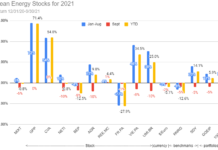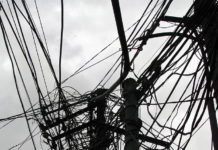Jennifer Runyon
The US Department of Commerce announced preliminary findings in the new trade case against Chinese and Taiwanese PV products.
On Friday evening the U.S. Department of Commerce (DOC) announced its preliminary findings in the antidumping duty (AD) investigations of imports of some crystalline silicon PV products from China and Taiwan. Most solar products entering the U.S. market from China and Taiwan will now face import duties.
According to a fact sheet released by the DOC, the AD law “provides U.S. businesses and workers with a transparent and internationally accepted mechanism to seek relief from the market-distorting effects caused by injurious dumping of imports into the United States. The DOC believes that this creates “an opportunity [for U.S. businesses] to compete on a level playing field.”
The DOC has prelimarily determined that “certain crystalline silicon photovoltaic products from China and Taiwan have been sold in the United States at dumping margins ranging from 26.33 to 58.87 percent, and 27.59 to 44.18 percent, respectively and will be collecting tariffs on the following manufacturers in the following amounts. The tariffs will be collected immediately, although final determinations will not be made until December.
From China:
- Trina Solar (TSL) – 26.33 percent
- Rensola (SOL) and Jinko (JKS) – 58.87 percent
- Suntech (STP) – 42.33 percent
- Another 42 unspecified manufactures – 42.33 percent
- China-wide entity (those who didn’t respond to the DOC’s questionnaire) -165.04 percent
From Taiwan:
- Gintech – 27.69 percent
- Motech – 44.18 percent
- All others 35.89 percent
The ruling is inclusive of many pieces of the solar manufacturing puzzle. According to the DOC fact sheet it includes the following:
Crystalline silicon photovoltaic cells, and modules, laminates and/or panels consisting of crystalline silicon photovoltaic cells, whether or not partially or fully assembled into other products, including building integrated materials.
For purposes of this investigation, subject merchandise also includes modules, laminates and/or panels assembled in the subject country consisting of crystalline silicon photovoltaic cells that are completed or partially manufactured within a customs territory other than that subject country, using ingots that are manufactured in the subject country, wafers that are manufactured in the subject country, or cells where the manufacturing process begins in the subject country and is completed in a non-subject country.
Subject merchandise includes crystalline silicon photovoltaic cells of thickness equal to or greater than 20 micrometers, having a p/n junction formed by any means, whether or not the cell has undergone other processing, including, but not limited to, cleaning etching, coating, and/or addition of materials (including, but not limited to, metallization and conductor patterns) to collect and forward the electricity that is generated by the cell.
Thin-film PV will not face tariffs. Also excluded are any products that are covered by the existing antidumping and countervailing duties as well as PV cells not exceeding 10,000 mm2 in surface area that are integrated into consumer goods who function to power that consumer good (like a solar-powered calculator).
The DOC estimates that in 2013, the value of solar PV products imported from China and Taiwan was $1.5 billion and $656 million, respectively.
U.S. Industry Reacts
SolarWorld (SRWRF), the solar petitioner in the case against China and Taiwan, commended the DOC’s determination.
“We and our workers are very gratified to hear that the U.S. government once again has moved to block foreign government interference in our economy and clear the way for the domestic production industry to be able to compete on a level playing field,” said Mukesh Dulani, president of SolarWorld Industries America Inc. “We should not have to compete with dumped imports or the Chinese government. Today’s actions should help the U.S. solar manufacturing industry to expand and innovate.”
Jigar Shah, president of the Coalition for Affordable Solar Energy (CASE) released a statement calling the determination “another unnecessary obstacle” that he said will “hinder the deployment of clean energy by raising the prices of solar products.”
He said: “Due to these tariffs, previously viable projects will go unbuilt, American workers will go unhired and consumers that could have saved money through solar energy may not be able to benefit.”
CASE maintains that America’s solar manufacturers are strong and are providing jobs for 29,000 U.S. workers. In addition almost 100,000 Americans are employed downstream in the system installation, sales, distribution and project development sectors.
The coalition collected the following statements from some of its members:
Ron Corio, President of Array Technologies, based in Albuquerque, NM and representing over 100 jobs said: “As a U.S. solar manufacturing company, we’re very disappointed in today’s anti-dumping determination. By increasing the price of solar power through tariffs, SolarWorld is shrinking the market for our products here in the United States and punishing successful U.S. solar businesses. Our company is proof that American solar manufacturing jobs will decrease under these special trade protections.”
John Morrison, COO of Strata Solar, based in Chapel Hill, NC and representing over 1,000 jobs said: “Due to their scale, the utility and large commercial solar sectors are particularly sensitive to the uncertainty and price increases caused by these tariffs. Until this dispute is resolved, our industry will build fewer projects and install less solar. It’s time to end the litigation, negotiate a solution and put more Americans back to work.”
Ocean Yuan, Founder and CEO of Grape Solar, based in Eugene, OR said: “My company assembles and sells complete solar energy kits directly to customers and in major retail stores across the country. The number one reason customers cite when switching to solar energy is cost savings, but these misguided tariffs are inflating prices. A negotiated solution to this dispute will ensure the continued growth of our industry and small businesses like mine.”
Chinese Industry Reacts
In an interview with Bloomberg news, Sebastian Liu, director of Investor Relations at Jinko Solar said that top Chinese manufacturers would elect to pay the 2012 duties without using cells from Taiwan or a third-country. Jennifer Liang, a Taipei-based analyst from KGI Securities Co told Bloomberg that the duties would hurt producers from Taiwan the most.
Taiwanese solar stocks including Motech, Gintech, E-Ton Solar and Neo Solar dropped in reaction to the news, said Bloomberg.
Organizations Urge a Settlement
CASE’s Shah believes that SolarWorld should work with the U.S. solar industry to end litigation “in favor of a win-win solution like the Solar Energy Industries Association (SEIA) settlement proposal.”
He said that CASE members represent the industry majority and that they “demand a s
olution that ends uncertainty in the marketplace by preventing further trade litigation and that allows solar power to compete cost-effectively with traditional energy sources, thus enabling the market’s further growth.”
Rhone Resch, president and CEO of SEIA echoed Shah. “Enough is enough. The Department of Commerce continues to rely on an overly broad scope definition for subject imports from China, adversely impacting both American consumers and the vast majority of the U.S. solar industry,” Resch said. “We strongly urge the U.S. and Chinese governments to ‘freeze the playing field’ and focus all efforts on finding a negotiated solution. This continued, unnecessary litigation has already done serious damage, with even more likely to result as the investigations proceed.”
Resch believes that a “win-win” solution is still achievable. “As the old saying goes, ‘where there’s a will, there’s a way.’ Today, the parties are finally engaged and all sides seem committed to finding a negotiated solution. I am encouraging my U.S. and Chinese industry colleagues to roll-up our sleeves, work together, and find a deal that’s good for everyone,” he said.
For more discussion about U.S. trade relations, play the video below.
Timeline for Next Steps
Final determination of the AD investigation is expected on December 15, 2014. If that final determination is affirmative then the International Trade Commission will issue its final determination on January 29, 2015 and the order will be issued on February 5, 2015.
Jennifer Runyon is chief editor of RenewableEnergyWorld.com and Renewable Energy World magazine, coordinating, writing and/or editing columns, features, news stories and blogs for the publications. She also serves as conference chair of Renewable Energy World Conference and Expo, North America. She holds a Master’s Degree in English Education from Boston University and a BA in English from the University of Virginia.
This article was originally published on RenewableEnergyWorld.com, and is republished with permission.








